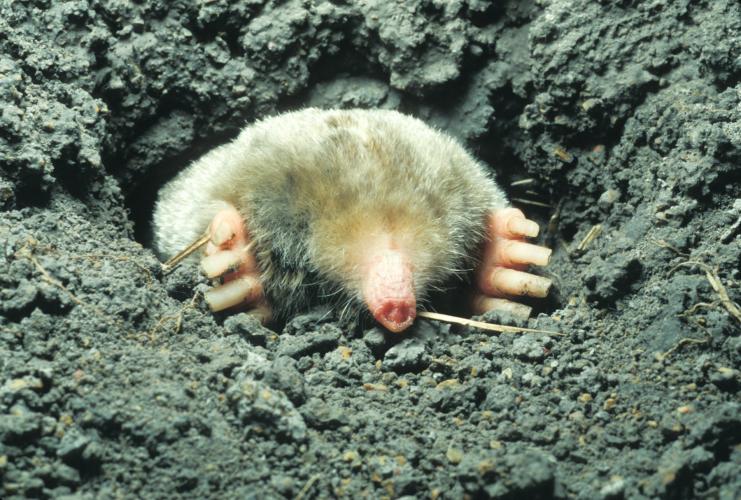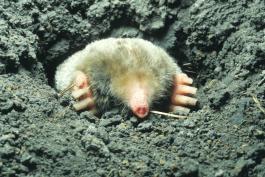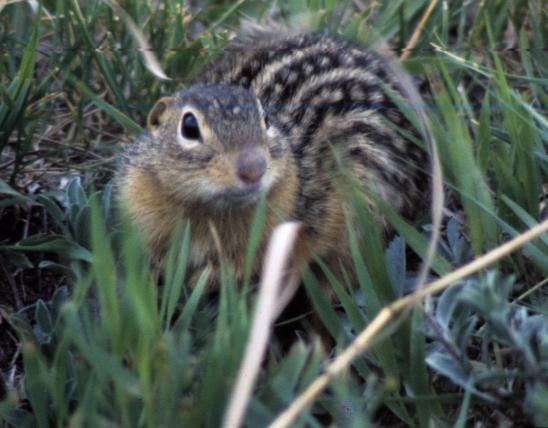
The eastern mole is chipmunk-sized, though it is not a rodent; it has palmlike, short front feet that are held over the head with palms facing outward. The mole uses its large hands to move through the soil in about the same way a person swims underwater. The head looks nearly featureless except for the flexible, piglike snout. Although the mole’s eyes are only good for telling light from dark, its senses of hearing, touch, and smell are acute. The velvety fur is characteristically slate gray but often appears silvery on freshly groomed moles and sooty black on juveniles. A cinnamon-brown staining on the chin and along the middle of the belly is common on adults. The tail is nearly naked and is highly sensitive to touch.
Total length: 5½–8 inches; tail length: ¾–1½ inches; weight: 1–5 ounces.

Statewide.
Habitat and Conservation
Moles live in a series of tunnels underground and may be found wherever the soil is sufficiently thick, pliable, and adhesive enough to support a tunnel system and is adequately populated with grubs, earthworms, and other prey items. In most cases it is not necessary to manage moles; to ensure healthy soils, their presence should be tolerated. When their presence cannot be tolerated at all, traps are usually the most effective way to control them.
Food
Grubs and earthworms constitute the bulk of their diet. They also prey on other soil-dwelling creatures such as beetles, spiders, centipedes, ant pupae, and cutworms. In fact, a mole can harvest more than 140 grubs and cutworms daily (many of which are destructive to your backyard plants). Moles can eat half their body weight a day!
Status
Common.
For a long time, moles and shrews used to be placed in a mammal order called Insectivora, which contained a variety of small insectivorous (insect-eating) mammals. But Insectivora has been divided into several new orders and is no longer an official grouping.
Today, most mammalogists agree that true shrews, moles, and solenodons, along with hedgehogs, gymnures, and desmans, belong in the same order. This new order is named Eulipotyphla. Molecular (DNA) evidence, which shows degrees of genetic relationships, prompted this reorganization.
Before order Eulipotyphla was proposed and accepted, true shrews, moles, and solenodons (but not the hedgehogs, gymnures, and desmans) were considered to be in order Soricomorpha. Slightly older references may still use this term.
Life Cycle
Each mole has its own system of tunnels and lives a solitary life. They are active day and night, resting for 3 hours, then becoming active again for 5 hours. Moles breed in late winter or spring and have a gestation period of about 4–6 weeks. Single annual litters of 2–5 young are born in March, April, or May. Young moles are born naked and helpless, but growth and development is rapid. About 4 weeks after birth, they leave the nest and fend for themselves.
Control
Human Connections
Though moles are routinely disliked for disfiguring lawns and inadvertently damaging plant roots, their tunneling also aerates and mixes soil, permitting air and rainwater to penetrate deeper. They also eat many destructive insects, including cutworms and the larvae of those bazillions of Japanese beetles.
Ecosystem Connections
Their digging and tunneling makes soils healthier, and their feeding on insects helps keep those populations in check. And although living underground offers some protection, moles still fall prey to snakes, hawks, owls, skunks, coyotes, and foxes.
































